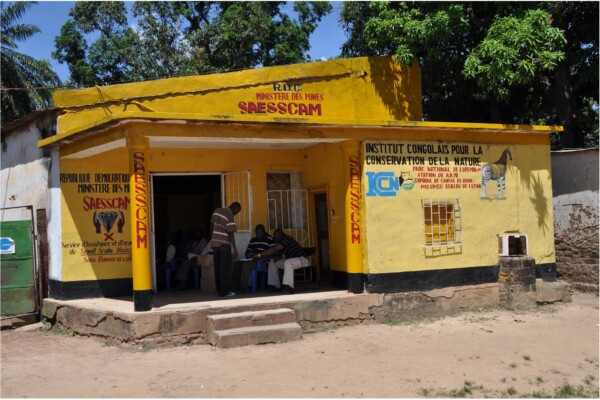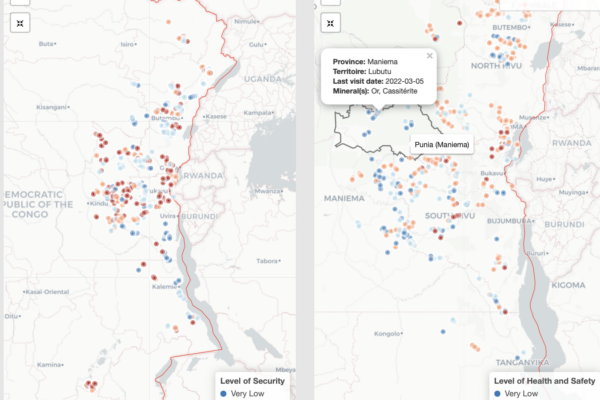
Exploitation minière et conflit dans l’est de la RDC: Une carte narrative interactive
11 mars 2024Financement des conflits, ingérence armée et sources d’insécurité au-delà du paradigme des « minerais de conflit » Dans cette carte narrative, IPIS présente les résultats de ses recherches sur le lien entre l’exploitation minière et le financement des conflits dans l’est de la République démocratique du Congo (RDC). Basée sur une enquête menée entre 2021-2023 dans 829 sites miniers actifs (représe

Kufatilia se transforme en réseau de la société civile, désormais doté d’une nouvelle plateforme de suivi des incidents miniers.
19 janvier 2024Première réunion annuelle du nouveau réseau Kufatilia En novembre 2023, les partenaires Kufatilia se sont rendus à Bunia et Bukavu, dans l’est de la République démocratique du Congo (RDC), pour assister à la première réunion annuelle du nouveau réseau Kufatilia. Composée de deux conférences distinctes en Ituri et au Sud-Kivu, la réunion a rassemblé vingt-deux organisations de la société civil

IPIS Event: Congolese cobalt, EU regulations, and direct investment
9 janvier 2024On the 30th of November, IPIS hosted its annual panel discussion, this time on current challenges facing the cobalt sector in the Democratic Republic of the Congo (DRC) and the potential impact of European Union (EU) regulations to improve these. Moderated by Lotte Hoex, the panel consisted of Esperant Mwishamali, independent researcher on cobalt artisanal and small-scale mining (ASM) in the DRC,

Analyse de la carte interactive des zones d’exploitation minière artisanale dans l’est de la République démocratique du Congo (Mise à jour 2023)
22 décembre 2023Depuis 2009, IPIS a cartographié et collecté des données sur plus de 2 800 sites d’exploitation minière artisanale et à petite échelle (EMAPE) dans l’est de la République démocratique du Congo (RDC). Dans ce rapport, IPIS fournit sa mise à jour 2023 de l’état de l’EMAPE dans l’est de la RDC, basée sur des données provenant de plus de 829 sites artisanaux et de petite échelle dans la zone entre 202

Increasing awareness of policy reforms on gender equality issues in artisanal and small-scale mining in eastern DRC: Case study of the Numbi, Nzibira and Nyabibwe sites
13 décembre 2023The mineral resources of the eastern Democratic Republic of the Congo’s (DRC) provide an important source of employment for both men and women involved in artisanal and small-scaling mining (ASM). Yet opportunities are not equal for men and women. Based on a series of interviews with various ASM stakeholders at the mines of Numbi, Nzibira and Nybibwe in the province of South Kivu, this

Cartographie des sites minieres artisanaux dans la région du Mambasa occidental, province de l’Ituri, République démocratique du Congo
22 novembre 2023La partie occidentale du territoire de Mambasa, dans la province de l’Ituri, fait l’objet d’une attention limitée de la part des autorités nationales et des partenaires internationaux. Pourtant, l’expansion des activités d’exploitation artisanale et à petite échelle de l’or (ASM) y est importante, y compris dans la Réserve de Faune à Okapis (RFO). Ces opérations minières ont provoqué des tensions

Déclaration conjointe d’ONG : Le règlement de l’UE sur les ‘minerais de conflits’ peine à atteindre ses objectifs
19 octobre 202320 ONG appellent l’UE à renforcer l’application des règles et à adopter de nouvelles mesures Téléchargez la déclaration conjointe Bruxelles, le 19 octobre 2023 Plus de six ans après son entrée en vigueur, le règlement de l’Union européenne sur l’approvisionnement responsable en étain, tungstène, tantale et en or provenant de zones de conflit ou à haut risque peine à atteindre ses principaux o

The EU Conflict Minerals Regulation: High stakes, disappointing results
19 octobre 2023The EU Regulation on the responsible supply of tin, tungsten, tantalum and gold (3TG) originating from conflict-affected and high-risk areas (CAHRAs) came into full force on 1 January 2021. Also known as the “Conflict Minerals” or “Responsible Minerals” Regulation, it aims to break the link between the exploitation and trade in 3TG on the one hand, and conflict financing on the othe

Voix du Congo: Le rôle de l’artisanat minier dans le processus de démobilisation et réinsertion des miliciens de la FRPI dans la chefferie de Walendu Bindi, Ituri
22 septembre 2023Une publication de la série: VOIX DU CONGO Située au nord-est de la République démocratique du Congo, la province de l’Ituri a connu près de deux décennies d’activisme du groupe armé Force de Résistance Patriotique de l’Ituri (FRPI). L’échec du programme de démobilisation, de désarmement et de réintégration (DDR) lancé en 2020 et resté inachevé a conduit les combattants de la FRPI à retourner de m

Sharing the results of two years of research into eastern DR Congo’s artisanal mining sector
12 juillet 2023Since 2021 and in partnership with USAID and the Congolese Ministry of Mines (through its technical service SAEMAPE), IPIS has been undertaking a large-scale project to map and analyse artisanal mining supply chains and conflict financing dynamics in eastern DRC. A restitution meeting was held in Goma (North Kivu) on June 21st, 2023 to present and discuss the results produced over the past two yea

Taxes et prélèvements dans les sites miniers artisanaux du Sud Kivu et de l’Ituri : combien paie un mineur artisanal ?
14 avril 2023Ce rapport est le résultat d’une étude de terrain de grande ampleur sur la fiscalité du secteur minier artisanal dans deux provinces de l’est de la République démocratique du Congo, l’Ituri et le Sud-Kivu. La principale conclusion est que les réglementations et les pratiques actuelles dans ce domaine contribuent non seulement à la contrebande de minerais – laissant une partie du potentiel fiscal d

Analyse de la carte interactive des zones d’exploitation minière artisanale dans l’Est de la République démocratique du Congo (2022)
29 novembre 2022télécharger le Synthèse (FR) Dans l’est de la République démocratique du Congo (RDC), le secteur de l’exploitation minière artisanale et à petite échelle (EMAPE) joue un rôle important dans l’économie locale. Alors que les conflits armés à grande échelle autour des richesses minières de la RDC ont considérablement diminué au cours des vingt dernières années, les acteurs armés continuent d’interfér

Responsible mining scorecard in eastern DRC
31 août 2022Over the years, IPIS has systematically collected mine site and trade hub level data on artisanal and small-scale mining (ASM) in eastern DRC. This data collection has enabled IPIS to generate a sizable database of more than 3,000 ASM sites that draws both on sites visited by IPIS and data from third party sources including the Congolese mining cadastre and the Mini

New large-scale mapping project of artisanal and small-scale mining in eastern DRC launched
10 novembre 2021Over the next two years, IPIS – in partnership with USAID, Tetra Tech and the Congolese Ministry of Mines (SAEMAPE) – will undertake a large-scale mapping effort of artisanal and small-scale mining sites in the eastern Democratic Republic of Congo (DRC), with the aim to provide observers, suppliers and policymakers with reliable data to understand artisanal mineral supply chains and conflict finan

Story map of ASM sites in the DRC
6 octobre 2020Explore IPIS’ web map of the eastern Democratic Republic of the Congo (DRC) with a guided narrative In its new story map, IPIS presents data gathered on eastern DRC’s artisanal mining sector and highlights key information from its reports investigating the interactions between natural resources and conflict dynamics in the region. Data was gathered on around 2,700 mining sites, and the principal m

Story map of ASM sites in Central African Republic
4 juin 2020Discover a new approach to IPIS’ interactive webmap of artisanal and small-scale mining (ASM) sites in the Central African Republic through this interactive story map. In partnership with national authorities in Central African Republic (CAR) and USAID’s Artisanal Mining and Property Rights project, IPIS mapped and analysed the artisanal mining sector in the western part of the country, and outlin

Mapping ASM sites in the Central African Republic: An update from our field teams
2 juillet 2019Since February 2019, IPIS is partnering with the Artisanal Mining and Property Rights (AMPR) project from the U.S. Agency for International Development (USAID) to increase awareness and understanding of the opportunities and challenges of establishing responsible gold supply chains in the Central African Republic (CAR). As part of this project, IPIS is supporting the Ministry of Mines in mapping a

Plateforme de suivi des incidents issus de l’artisanat minier dans l’est de la RDC.
13 juin 2019Depuis fin 2018, témoins et victimes peuvent rapporter les incidents et accidents en lien avec la production, le transport et le commerce de minéraux issus de l’artisanat minier ayant lieu dans les provinces du Sud-Kivu et d’Ituri, dans l’est de la RDC. En collaboration avec Ulula et le Centre d’Expertise en Gestion Minière (CEGEMI) basé à Bukavu, IPIS a développé un nouveau système anonyme de sig

Data sharing on the socio-economic and human rights impact of mining in Tanzania
15 mai 2019Tanzania, May 2019 Since January 2017, IPIS has been working on a project to map the socio-economic and human rights impact of mining in northwest Tanzania. This project is supported by the Belgian development cooperation under a programme on human rights and digitisation. By using mobile technologies such as mobile data collection, GIS mapping, mobile incident reporting and phone surveys throug

Presentation of SAESSCAM database on Artisanal and Small-scale Mining
26 novembre 2015From November 17 to 19, IPIS presented its work during a multi stakeholder meeting in Kinshasa as part of a project to support artisanal and small scale mining in DRC. In partnership with Pact and Estelle Levin LTD, IPIS has provided capacity reinforcement for the Service d’Assistance et d’Encadrement du Small Scale Mining (SAESSCAM), a governmental agency. IPIS focused on reviewing existing data

